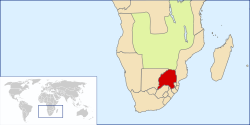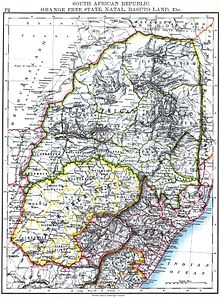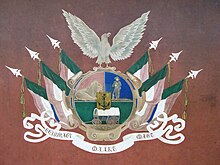Undid revision 626198836 by Srnec (talk) |
Undid revision 626198836 by Srnec (talk) |
||
| Line 10: | Line 10: | ||
| region = Southern Africa |
| region = Southern Africa |
||
| country = Zuid-Afrikaansche Republiek |
| country = Zuid-Afrikaansche Republiek |
||
| life_span = |
| life_span = 1856–1877<br>1881–1902<br />1914–1915 |
||
| year_start = 1852 |
| year_start = 1852 |
||
| year_end = |
| year_end = 1915 |
||
| date_start = 17 January |
| date_start = 17 January |
||
| date_end = |
| date_end = 4 February |
||
| p1 = Klein Vrystaat |
| p1 = Klein Vrystaat |
||
| flag_p1 = Flag of Klein Vrystaat.svg |
| flag_p1 = Flag of Klein Vrystaat.svg |
||
| Line 48: | Line 48: | ||
| event4 = [[Treaty of Vereeniging]] |
| event4 = [[Treaty of Vereeniging]] |
||
| date_event4 = 31 May 1902 |
| date_event4 = 31 May 1902 |
||
| event5 = Republic Declared (Maritz Rebellion) |
|||
| date_event5 = 7 October 1914.{{sfn|Strachan|2001|p=551}} |
|||
| event6 = Disestablished |
|||
| date_event6 = 4 February 1915 |
|||
| stat_year1 = 1870<ref name="Mackay1870">{{cite book|author=Alexander Mackay|title=Manual of modern geography, mathematical, physical, and political|url=http://books.google.com/books?id=HHEDAAAAQAAJ&pg=PA484|year=1870|page=484}}</ref> |
| stat_year1 = 1870<ref name="Mackay1870">{{cite book|author=Alexander Mackay|title=Manual of modern geography, mathematical, physical, and political|url=http://books.google.com/books?id=HHEDAAAAQAAJ&pg=PA484|year=1870|page=484}}</ref> |
||
| stat_area1 = 191789 |
| stat_area1 = 191789 |
||
| Line 127: | Line 131: | ||
The [[Second Boer War]] was a watershed for the [[British Army]] in particular and for the [[British Empire]] as a whole. It was here that the British used [[British concentration camps|concentration camp]]s where small babies, young children and women were held in camps without adequate food or medical care.<ref name="archive.org"/> The abhorrent conditions in these camps caused the death of 4 177 women, 22 074 children under sixteen. The camps were unmitigated humanitarian disasters and death rates varied between 344 and 700 per 1000.<ref>{{cite book|last1=Totten|first1=Samuel|last2=Bartrop|first2=Paul R.|title=Dictionary of Genocide|chapter=Concentration Camps, South African War|date=2008|publisher=Greenwood Press|location=Westport, CT|isbn=9780313346415|pages=84–85|url=http://books.google.co.za/books?id=rgGA91skoP4C}}</ref> There is {{commonscat inline|Second Boer War concentration camps}} |
The [[Second Boer War]] was a watershed for the [[British Army]] in particular and for the [[British Empire]] as a whole. It was here that the British used [[British concentration camps|concentration camp]]s where small babies, young children and women were held in camps without adequate food or medical care.<ref name="archive.org"/> The abhorrent conditions in these camps caused the death of 4 177 women, 22 074 children under sixteen. The camps were unmitigated humanitarian disasters and death rates varied between 344 and 700 per 1000.<ref>{{cite book|last1=Totten|first1=Samuel|last2=Bartrop|first2=Paul R.|title=Dictionary of Genocide|chapter=Concentration Camps, South African War|date=2008|publisher=Greenwood Press|location=Westport, CT|isbn=9780313346415|pages=84–85|url=http://books.google.co.za/books?id=rgGA91skoP4C}}</ref> There is {{commonscat inline|Second Boer War concentration camps}} |
||
===Maritz Rebellion=== |
|||
Four years after the Union, the Republic appeared again as an abortive state that existed only for about a year.{{sfn|Strachan|2001|p=551}} |
|||
==Political Structure of the ZAR== |
==Political Structure of the ZAR== |
||
Revision as of 16:30, 19 September 2014
South African Republic Zuid-Afrikaansche Republiek | |||||||||||
|---|---|---|---|---|---|---|---|---|---|---|---|
| 1856–1877 1881–1902 1914–1915 | |||||||||||
Coat of arms of South African Republic
Coat of arms
| |||||||||||
| Anthem: Transvaalse Volkslied | |||||||||||
 Location of the South African Republic, circa 1890. | |||||||||||
| Capital | Pretoria 25°43′S 28°14′E / 25.717°S 28.233°E | ||||||||||
| Common languages | Dutch | ||||||||||
| Religion | Nederduitsch Hervormde Kerk | ||||||||||
| Government | Republic | ||||||||||
| President | |||||||||||
• 1857–1863 | Marthinus Wessel Pretorius | ||||||||||
• 1883–1902 | Paul Kruger | ||||||||||
• 1900–1902 | Schalk Willem Burger (acting) | ||||||||||
| History | |||||||||||
• Established | 17 January 1852 | ||||||||||
| 20 December 1881 | |||||||||||
| 27 February 1884 | |||||||||||
| 11 October 1899 | |||||||||||
| 31 May 1902 | |||||||||||
• Republic Declared (Maritz Rebellion) | 7 October 1914.[1] | ||||||||||
• Disestablished | 4 February 1915 | ||||||||||
• Disestablished | 4 February 1915 | ||||||||||
| Area | |||||||||||
| 1870[2] | 191,789 km2 (74,050 sq mi) | ||||||||||
| Population | |||||||||||
• 1870[2] | 120,000 | ||||||||||
| Currency | South African Republic pond | ||||||||||
| |||||||||||
| Today part of | |||||||||||
The South African Republic , often referred to as the Dutch: Zuid-Afrikaansche Republiek, the ZAR, The Transvaal, and sometimes even the Republic of Transvaal was an independent and internationally recognised country in southern Africa from 1852 to 1902. The country defeated the British in what is often referred to as the First Boer War and remained independent until the end of the Second Boer War on 31 May 1902, when it was forced to surrender to the British. The territory of the ZAR became known after this war as the Transvaal Colony.
Name and etymology
Zuid-Afrikaansche Republiek (ZAR)
Constitutionally the name of the country was Zuid-Afrikaansche Republiek (South African Republic or ZAR). Many people also called the ZAR, Transvaal, in reference to the area over (or trans) the Vaal River[3] including the British press and the press in Europe. In fact the name "Transvaal" was later so often used that later the British objected to the use of the real name (The South African Republic). The British pointed out that the Convention of Pretoria of 1881-08-03[4] referred to the 'Transvaal Territory' and that the Transvaal and the South African Republic did not have the same boundaries.[5] However, in the London Convention dated 1884-02-27,[4]: 469–474 a subsequent treaty between Britain and the ZAR, Britain acquiesced and reverted to the use of the true name, "The South African Republic".

Transvaal
The name of the South African Republic was of such importance that on 1 September 1900 the British declared by special proclamation that the name of the South African Republic be changed[4]: 514 from "South African Republic" to "The Transvaal" and that the entire territory shall henceforth and forever be known as "The Transvaal" This proclamation was issued during the second boer war and whilst the ZAR was still an independent country.
On the 31st of May 1902 The Vereeniging Peace Treaty was signed, with the country of "The Transvaal" and the British Government which also converted the ZAR into the Transvaal Colony. The treaty established a Municipal Government, Witwatersrand District court and the High Court of Transvaal.[4]: 515 On the 20th of May 1903 and Inter Colonial Council[4]: 516 was established, to manage the colonies of the British Government. The name "Transvaal" was finally changed in 1994, when the ANC Government broke up the Transvaal area and renamed the core, to "Gauteng".
History
Early History
In paleolithic times, between 2.2 to 3.3 million years ago, hominds lived within the geographic area of the ZAR. The earliest hominid bones, between 2.2 to 3.3 million years old, was discovered at Sterkfontein in 1994. In 1938 Paranthropus robustus bones were found at Kromdraai, and during 1947 several more examples of Australipitecus africanus were uncovered in Sterkfontein. The pastoral San People lived on the lands of Southern Africa and they were later joined by Bantu people from North Africa and even later joined by the European people from Europe. Bantu peoples, who displaced the San people, were themselves decimated and scattered by the Mfecane which left most of the lands of the ZAR abandoned and vacant. The Boers constantly tried to expand their territories but found strong resistance from the Bantu peoples and specifically the Sotho people and the Zulu people.
Formation
The Zuid-Afrikaansche Republiek came into existence on 17 January 1852 when the United Kingdom signed the Sand River Convention treaty with about 40,000 boer people, recognising their independence in the region to the north of the Vaal River. The first president of the Zuid-Afrikaansche Republiek was Marthinus Wessel Pretorius, elected in 1857, son of Boer leader Andries Pretorius, who commanded the Boers to victory at the Battle of Blood River. Here also, is a List of Presidents of the South African Republic. The capital was established at Potchefstroom and later moved to Pretoria. The parliament as called the Volksraad and had 24 members.
Independence
The South African Republic became fully independent on the 27 February 1884 when the London Convention was signed. The country independently also entered into various agreements with other foreign countries after that date.


Expansion
On the 23rd November 1859[4]: 420–422 the independent Republic of Lijdenburg merged with the Zuid Afrikaansche Republiek. On 9 May 1887, burghers the territories of Stellaland and Goosen[4]: 479 (sometimes referred to as Goshen) were granted rights to the ZAR franchise. On the 25th of July 1895 the burghers that took part in the war at Zoutpansberg,[4]: 505 were granted citizenship of the ZAR.
Constitution and laws
The constitution of the Zuid Afrikaansche Republiek has been referred to as legally interesting for its time.[6] It contained provisions for the division between the political leadership and office bearers in government administration. The legal system consisted of higher and lower courts and had adopted a jury system. The laws were enforced by the South African Republic Police (Zuid-Afrikaansche Republiek Politie or ZARP) which were divided into Mounted Police (Rijdende Politie) and Foot Police.
Racism
The constitution promoted racialism as it treated European (white) people differently from Native (black) people. Although slavery was illegal in the constitution and foreigners (white and black) were discriminated against, black foreigners had fewer rights than their white counterparts. At this time in history, this was very similar to many other European countries as well as in the new world. Discrimination on the basis of race was prevalent in the ZAR and even coloured British subjects were forced to reside in ghettos outside cities with Asian and black races, whilst white races were free to live anywhere. One of the Racist excuses often used by the ZAR Government was "sanitation and regard to public health necessitated that measure of segregation"[7]
Language and culture
Language
On the 30 July 1888 the high Dutch language was declared as the only language[4]: 481–482 to be used in the country. This usage was not only in government but also in schools, trade and for general use. All other languages were declared as "foreign".[8] These changes to the ZAR laws made the use of all other foreign languages illegal in the ZAR. Use of any foreign language was subject to criminal penalty[4]: 483 and fine of 20 ZAR Pond for each offense. The British similarly had declared English to be the only language spoken in the Cape Colony some decades earlier to outlaw[9] the Dutch Language. The discovery of gold in 1885 led to a major influx of uitlanders. By 1896 the language of government and citizens remained Dutch but in many market places, shops and homes the English language was spoken.[10]
Boer Wars
Civil War 1861-1864
Secucuni War 1876
First Boer War

On 12 April 1877, Britain issued a proclamation called: "ANNEXATION OF THE S.A. REPUBLIC TO THE BRITISH EMPIRE"[4]: 448–449 In the proclamation, the British claim that the country is unstable, ungovernable, bankrupt and facing civil war.
The Zuid Afrikaansche Republiek viewed this proclamation as an act of aggression,[4]: 454–455 and resisted. Instead of declaring war, the country decided to send a delegation to United Kingdom and the USA, to protest. This did not have any effect and the First Boer War formally broke out on 20 December 1880. The First Boer War was the first conflict since the American Revolution in which the British had been decisively defeated and forced to sign a peace treaty under unfavourable terms. It would see the introduction of the khaki uniform, marking the beginning of the end of the famous Redcoat. The Battle of Laing's Nek would be the last occasion where a British regiment carried its official regimental colours into battle. The Pretoria Convention of 1881 was signed on 3 August 1881 and ratified on 25 October 1881 by the Zuid Afrikaansche Republiek (where the Zuid-Afrikaansche Republiek is referred to by the name "Transvaal Territory"). The Pretoria Convention of 1881[4]: 456–457 was superseded in 1884 by the London Convention,[4]: 469–470 and in which the British suzerainty over the South African Republic, was relinquished. The British Government, in the London Convention, accepted the name of the country as The South African Republic. The convention was signed in duplicate, in London on 27 February 1884 by Hercules Robinson, S.JP. Kruger, S.J. Du Toit and N.J. Smit and later ratified by the South African Republic (Zuid-Afrikaansche Republiek) Volksraad.
In 1885 extremely rich Gold reefs were discovered in the ZAR. The South African Republic burghers were farmers and not miners and much of the mining fell to immigrants. The immigrants were also referred to as "outlanders" (uitlanders). By 1897 the immigrants had invested over 300 000 000 British Pounds in the ZAR goldfields.

Mapoch War 1883
Western frontier war 1885
Second Boer War
Britain first attacked the independent country of South Africa in December 1895, the Jameson Raid. The British started building up massive amounts of troops and resources at the borders of the ZAR. Then they demanded voting rights for the 50,000 British nationals and the 10, 000 other nationals in South Africa, even though none of these nationals were at that time South African citizens. Kruger rejected the British demand and called for the withdrawal of British troops from the ZAR's borders. When the British refused, Kruger declared war against Britain. Britain was joined in the war by forces and armies from other countries and even independent countries, Australia, Canada and New Zealand as well as forces and citizens of colonies like the Colony of Natal and the Cape Colony. This war was also the first war in the history of the independent country of Australia fought in.
The Second Boer War was a watershed for the British Army in particular and for the British Empire as a whole. It was here that the British used concentration camps where small babies, young children and women were held in camps without adequate food or medical care.[11] The abhorrent conditions in these camps caused the death of 4 177 women, 22 074 children under sixteen. The camps were unmitigated humanitarian disasters and death rates varied between 344 and 700 per 1000.[12] There is ![]() Media related to Second Boer War concentration camps at Wikimedia Commons
Media related to Second Boer War concentration camps at Wikimedia Commons
Maritz Rebellion
Four years after the Union, the Republic appeared again as an abortive state that existed only for about a year.[1]
Political Structure of the ZAR
Officials
- President of the Zuid-Afrikaansche Republiek
- State Secretary of the Zuid-Afrikaansche Republiek
- State Attorney of the Zuid-Afrikaansche Republiek
Divisions
The country was divided into 17 districts:[10]
- Pretoria district: Pretoria
- Potchefstroom district: Potchefstroom, Ventersdorp, Klerksdorp, Venterskroon, Wolmaranstad
- Rustenburg district: Rustenburg
- Waterberg district: Nylstroom, Hartingsburg
- Zoutpansberg district: Pietersburg, Haenertsburg, Woodbush, Eersteling, Marabastad, Smitsdorp
- Lydenburg district: Lydenburg, Pilgrim's Rest, Barberton, Eureka City, FairView, Moodies, Jamestown
- Middelburg district: Middelburg, Roossenekal
- Heidelberg district: Heidelberg, Johannesburg, Elsburg, Boksburg, Krugersdorp
- Wakkerstroom district: Wakkerstroom, Amersfoort
- Piet Retief district: Piet Retief
- Utrecht district: Utrecht, Luneburg
- Bloemhof district: Christiania, Bloemhof, Schweizer-Reneke
- Marico district: Zeerust, Jacobsdal, Ottoshoop
- Lichtenburg district: Lichtenburg
- Standerton district: Standerton, Bethal
- Ermelo district: Ermelo, Amsterdam, Carolina
- Vryheid district: Vryheid
Flag
The national flag of the ZAR featured three horizontal stripes of red, white, and blue (mirroring the Dutch national flag), with a vertical green stripe at the hoist, and was known as the Vierkleur (lit. four colours). The former national flag of South Africa (from 1927 to 1994) had, as part of a feature contained within its central white bar, a horizontal flag of the Transvaal Republic (ZAR).
See also
References
- ^ a b Strachan 2001, p. 551.
- ^ Alexander Mackay (1870). Manual of modern geography, mathematical, physical, and political. p. 484.
- ^ Tamarkin (1996). Cecil Rhodes and the Cape Afrikaners. pp. 249–250.
- ^ a b c d e f g h i j k l m n Eybers (1917). Select_constitutional_documents_illustrating_South_African_history_1795-1910. pp. 455–463.
- ^ Irish University Press Series: British Parliamentary Papers Colonies Africa, (BPPCA Transvaal Vol 37 (1971) No 41 at 267)
- ^ Entry: South African Law Review1954. Butterworth's South African Law Review, 1954
- ^ "Origin of the Anglo-Boer War Revealed – C. H. Thomas (originally published in 1899 by Hodder & Stoughton)".
- ^ (Law articles 1017/1025 dd. 13 Juli 1888 & article 1026/1027, dd. 14 Juli 1888 & article 1030, dd. 16 Juli 1888)
- ^ Kachru, Braj; Kachru, Yamuna; Nelson, Cecil (2009). The Handbook of World Englishes. John Wiley & Sons. pp. 160–161. ISBN 1405188316.
- ^ a b De Villiers, John (1896). The Transvaal. London: Chatto & Windus. p. 14. Cite error: The named reference "devilliers" was defined multiple times with different content (see the help page).
- ^ a b "HOBHOUSE E - THE BRUNT OF THE WAR - METHUEN & CO (1902)".
- ^ Totten, Samuel; Bartrop, Paul R. (2008). "Concentration Camps, South African War". Dictionary of Genocide. Westport, CT: Greenwood Press. pp. 84–85. ISBN 9780313346415.
